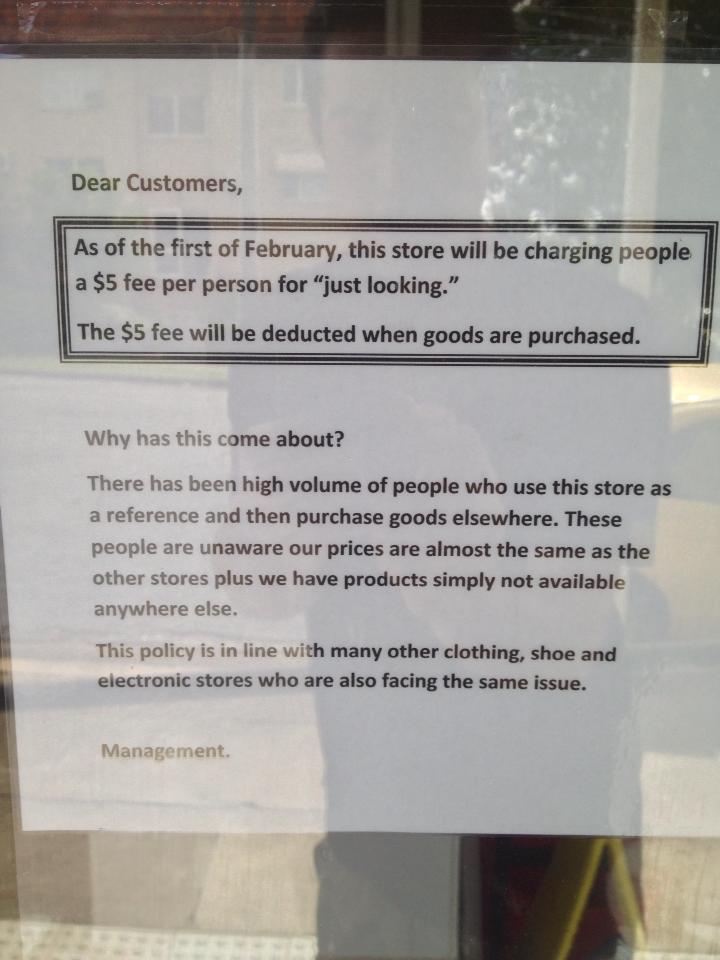Browser consumers are not new. Academic papers dating back to the 80’s are mentioning this behavior and called for researching it. posing what retailers consider being a great threat to their business. Today however they actually pose also the question of the survival of the brick-and-mortar retail sector vs. online retailing; browser consumers are visiting stores and then buying online, an option which didn’t obviously exist 30 years ago. Retailers feel threatened by what may appear as a deviant behavior. We talked about it on this blog and this topic has been also been popular in the press for months now. But what we just came across reveals how unprepared retailers are. This is an amazing story of an unexpected reaction.
Browsing behavior is felt as a threat by retailers
Our attention was caught recently by an article posted on the blog of Torben Rick called “Disruptive change forcing bricks and mortar to charge fees“. This article presents an “initiative” started by a gluten-free specialty store based in Brisbane (Australia) to charge 5$ on customers who are “just looking” (see image below).
Commenting on this, T. Ricks writes :
Why implement a policy that will obviously be unpopular among customers? Celiac Supplies goes on to explain that the new policy is meant to fight individuals who “use this store as a reference and then purchase goods elsewhere: “This policy is in line with many other clothing, shoe and electronic stores who are also facing the same issue” the sign concludes.
T. Ricks then concludes on a business-centered way with these words
But this is the exact wrong response. Rather than showing ways to add more value to the customer experience so they want to come in, they’re taking away value and giving customers reasons to never go in in the first place.
In fact, this seems to be screaming out “hey, you get better deals online and we know it!”
We must admit we are pretty in line with the above. Such browsing behavior may indeed call for a revamp of the customer experience in order for the customer to understand which value he or she can get from visiting and purchasing from the brick-and-mortar store. No doubt on that and that’s a straightforward and logical conclusion. We would like however to offer another view on the phenomenon.
Something is changing and it’s time to cope with change
Browsing behavior is nothing but a deviant customer behavior. Deviant consumer behaviors have received in the marketing literature many names: non-normative behaviors, dysfunctional behavior, unethical behavior. “Jaycustomers” is also used.
We would like to propose here an alternative interpretation of the phenomenon observed in Brisbane, an interpretation that was inspired to us by an article written by Fisk et al. (2010) : “Customers behaving badly : a state of the art review, research agenda and implications for practitioners.”
This article deals with all types of deviant consumers’ behaviors (fraud, theft, violence, aggressiveness, impoliteness, …) and stresses that deviant behaviors are dependent on the sector and on the culture. Some behaviors that may appear deviant in certain cultures can be accepted in other. This is a question of social acceptability. For instance chewing gums are accepted in many countries but banned in Singapore for the harm they cause to the Society. The social norms have changed in Singapore and chewing gums has become a deviant behaviors.
“Browsing” is also considered for now as a deviant behavior for the harm it causes to brick-and-mortar retailers. The latter have a heavier cost structure to sustain than online pure players and suffer from “browsing”.
Fisk et al. write
One other example of a manifest positive function linked to customer misconduct is that when it occurs with regularity and is exhibited by a significant number of patrons, the circumstance signals the need for change.
and quoting Berry and Seiders (2008) they add
Companies must acknowledge the unfair behavior of certain customers and manage them effectively … Denying the existence and impact of unfair customers erodes the ethics of fairness upon which great service companies thrive.
Conclusion : you must recognize change and adapt
Adding more to your customer experience, enhancing customer satisfaction, … may all seem natural and sound reactions to browsing behaviors. But those solutions fail to recognize that what happens is not an small phenomenon. It’s a trend that will eventually change the social norms and become socially acceptable. Although satisfying your customers remain crucial to keep them (centrality of loyalty in modern marketing), we believe successful retailers will recognize that their very business model must change to cope with such behaviors. Online players are already invading the brick-and-mortar sphere. Offline players should rethink their presence and offer a better way for customers to “browse” in an environment free of social pressure.
Posted in Marketing, Research.

